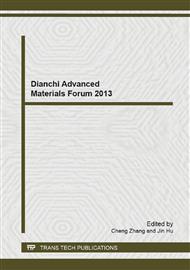[1]
H. Kodama, H. Sakamoto, T. Miyoshi. High-tech ceramics view points and perspectives. J. Am. Ceram. Soc., 72(1989): 551-556.
Google Scholar
[2]
R. Moene, R. Th. Boon, J. Schoonman, et al. Coating of activated carbon with silicon carbide by chemical vapor deposition. Carbon, 34(1996): 567–579.
DOI: 10.1016/0008-6223(95)00214-6
Google Scholar
[3]
C. Isola, P. Appendino, F. Bosco, et al. Protective glass coating for carbon–carbon composites. Carbon, 36(1998): 1213–1218.
DOI: 10.1016/s0008-6223(98)00100-6
Google Scholar
[4]
L. F. Cheng, Y. D. Xu, L.T. Zhang, et al. Oxidation behavior of three dimensional C/SiC composites in air and combustion gas environments. Carbon, 38 (2000) 2103–2108.
DOI: 10.1016/s0008-6223(00)00068-3
Google Scholar
[5]
Y. C. Zhu, S. Ohtani, Y. Sato, et al. The improvement in oxidation resistance of CVD-SiC coated C/C composites by silicon infiltration pretreatment. Carbon, 36(1998): 929-935.
DOI: 10.1016/s0008-6223(97)00207-8
Google Scholar
[6]
J. I. Kim, W. J. Kim, D. J. Choi, et al. Design of a C/SiC functionally graded coating for the oxidation protection of C/C composites. Carbon, 43(2005): 1749-1757.
DOI: 10.1016/j.carbon.2005.02.025
Google Scholar
[7]
M. W. Chen, H. P. Qiu, J. Jiao, et al. preparation of high performance SiCf/SiC composites through PIP Process. Key Eng. Mater., 544(2013): 43-47.
DOI: 10.4028/www.scientific.net/kem.544.43
Google Scholar
[8]
A. Sayir. Carbon fiber reinforced hafnium carbide composite. J. Mater Sci, 39(2004): 5995-6003.
DOI: 10.1023/b:jmsc.0000041696.64055.8c
Google Scholar
[9]
V. Craciun, D. Craciun, J. M. Howard, et al. Pulsed laser deposition of crystalline ZrC thin films. Thin Solid Films, 515(2007): 4636-4639.
DOI: 10.1016/j.tsf.2006.11.122
Google Scholar
[10]
M. S. Song, B. Huang, M. X Zhang, et al. Formation and growth mechanism of ZrC hexagonal platelets synthesized by self-propagating reaction. J. Cryst. Growth, 310(2008): 4290-4294.
DOI: 10.1016/j.jcrysgro.2008.07.016
Google Scholar
[11]
Q. F. Tong, J. L. Shi, Y. Z. Song, et al. Resistance to ablation of pitch-derived ZrC/C composites. Carbon, 42(2004): 2495-2 500.
DOI: 10.1016/j.carbon.2004.05.006
Google Scholar
[12]
Y. J. Yan, Z. R. Huang, S. M. Dong, et al. Pressureless sintering of high-density ZrB2-SiC Ceramic composites. J. Am. Ceram. Soc., 89(2006): 3589-3592.
DOI: 10.1111/j.1551-2916.2006.01270.x
Google Scholar
[13]
X. J. Zhou, G. J. Z hang, Y. G. Li, et al. Hot pressed ZrB2-SiC-C ultra high temperature ceramics with polycarbosilane as a precursor. Mater. Lett., 61(2007): 960-963.
DOI: 10.1016/j.matlet.2006.06.024
Google Scholar
[14]
X. H. Zhang, P. Hu, J. C. Han, et al. Ablation behavior of ZrB2-SiC ultra high temperature ceramics under simulated atmospheric re-entry conditions. Compos. Sci. Technol., 68(2008): 1718-1726.
DOI: 10.1016/j.compscitech.2008.02.009
Google Scholar
[15]
M. W. Chen, M. Ge, W. G. Zhang. Preparation and Properties of Hollow BN Fibers Derived From Polymeric Precursors. J. Eur. Ceram. Soc., 32( 2012): 3521–3529.
DOI: 10.1016/j.jeurceramsoc.2012.04.012
Google Scholar


